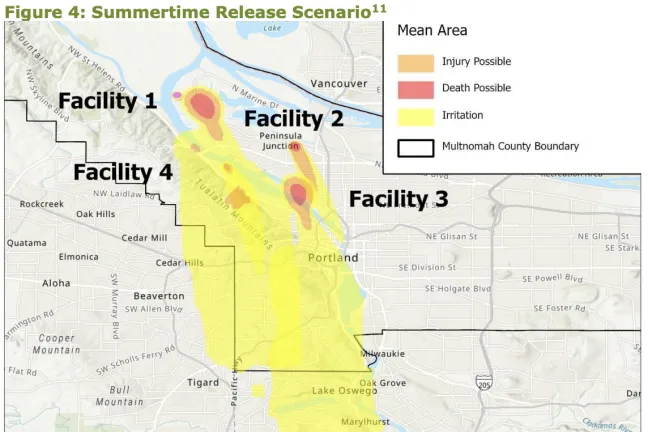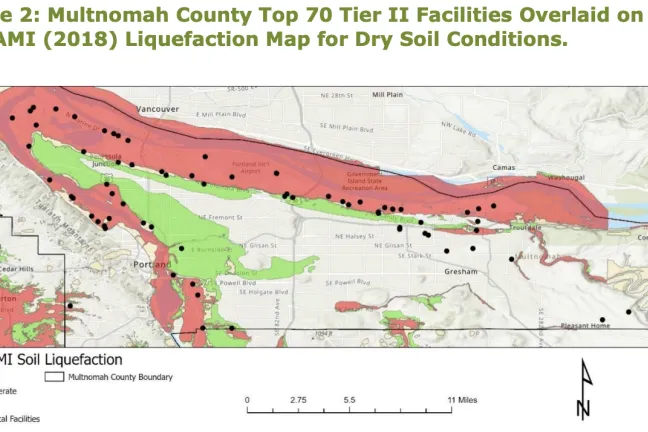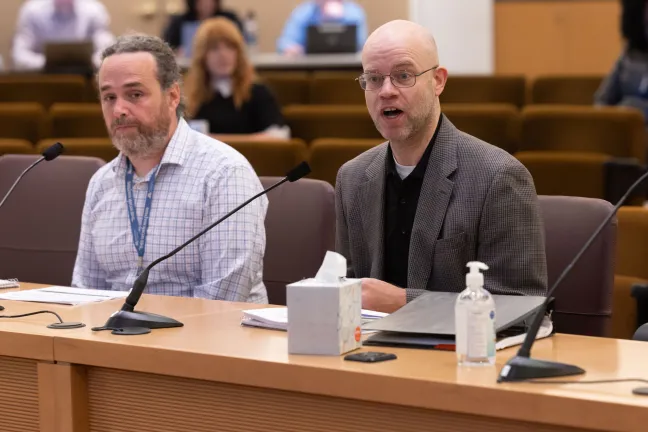Before voting on a resolution to adopt Multnomah County’s Natural Hazards Mitigation Plan Thursday, Oct. 13, the Board of County Commissioners received a briefing that highlighted the sobering risks that both natural and human-caused events pose to the community.
Chris Voss, director of County Emergency Management, and Dave Lentzer, interim planning division chief, presented three reports:
While most earthquake and wildfire threats are increasingly understood and leading to widespread preparation,
It is the first time researchers have focused on releases from the more than 1,100 facilities in Multnomah County that store and use a variety of hazardous chemicals including acids, potentially explosive chemicals, and chemicals with toxic inhalation hazard properties.
Specifically, Portland State University researchers focused on four locations in north Portland and Northwest Portland where toxic acids and explosive chemicals are stored above ground or in pressurized containers. Because they were built on loose, sandy soils and a high groundwater table, the shaking ground will likely liquify and cause the containers to rupture. Depending on the season, wind and weather conditions, the releases of chemicals into the air could potentially kill more than 2,500 residents and injure more than 17,000. The impact would be so great in part because first responders, communication and transportation damaged by the quake would make evacuation delayed or even unlikely.
The report urged immediate state, federal and local collaboration on policy to help reduce risk.
On the same day as the briefing, Chair Jessica Vega Pederson sent
“The average person in their house doesn’t have the ability to protect themselves from risks like these,” cautioned Chair Vega Pederson, “so it’s incumbent upon us and the (state) government to take the steps to make sure that we are being protective.
The Hazardous Materials Report, “The Risk of Earthquake-Induced Hazardous Materials Releases in Multnomah County, Oregon: Two Scenarios Examined,’’ was conducted jointly by the Multnomah County Department of Emergency Management, the Oregon State Fire Marshal’s Office and Portland State’s Institute of Sustainable Solutions. Lead researcher Luke Hanst focused on facilities that store toxic chemicals under pressure, and identified 70 so-called Type II facilities in Multnomah County, most located in areas that are very vulnerable to earthquakes.
The scope of the study did not allow for an investigation of all 70 facilities, and instead honed in on a subset of facilities in Northwest and North Portland. In that area, researchers identified 27 hazardous materials facilities that were deemed most concerning based on age of construction and proximity to residential areas. Each facility is located in an area expected to receive at least moderate or heavy damage during and after a seismic event.
The research team found that 23 of these facilities were assumed to be seismically vulnerable based on the date of construction. Of the 15 that are expected to pose a risk of toxic gas plumes, 11 are stored in either above-ground tanks or pressurized cylinders, and 12 are seismically vulnerable. The study evaluated the risk of uncontrolled release of toxic gasses from four facilities. The data on the type and location of chemicals is protected because of homeland security concerns, so, for the purposes of the study, the type of chemical and the location of the facility were anonymized.
Although hazardous chemical containers are built to higher standards than oil and fuel tanks, the concern during a large seismic event is that the soil under these facilities will liquify.
Companies that handle hazardous materials have tended to locate their hazardous chemical facilities on the worst kinds of soils in the County in terms of what will withstand a large seismic event, explained Voss. “We didn’t always obviously understand sort of the risk, and those areas are probably a little bit more cost effective to put these locations.”
The report includes scenarios for a 9.0 Cascadia subduction zone earthquake in both summer and winter to account for differences in humidity, wind speed and weather conditions that will determine the direction in which a toxic gas plume blows, as well as its size.
At the briefing, Voss explained that next steps might include working with surrounding counties to map their facilities since “it’s quite possible there's tanks on the other side of a county line that might impact us, depending on which way the wind is blowing. You see these plumes actually go quite far for a lot of these facilities.”
While Voss stressed his concern about the possibility of a toxic gas plume after a seismic event, he also expressed optimism for what the County can accomplish before a Cascadia earthquake strikes. “We’re really very fortunate at this point in time…We have an opportunity to look, improve, mitigate and reduce the risk.”
Board comment
The Board has worked to address earthquake hazards before. In 2020, Multnomah County Office of Sustainability and the City of Portland Bureau of Emergency Managementcommissioned a study of the Critical Energy Infrastructure Hub in Northwest Portland to characterize and quantify the anticipated damages from a Cascadia earthquake. County Commissioners Sharon Meieran and Susheela Jayapal helped draw attention to the analysis which forecast up to $2.6 billion in costs from the failure of 630 storage tanks on the west bank of the Willamette River.
Then-Chair Deborah Kafoury teamed with city and state leaders to help pass Senate Bill 1567 that now requires fossil fuel storage companies to begin to assess and plan for such an event.
On Thursday, the Board expressed concern and some hope they could influence policy again.
“The additional depth that you provided about the inhalation hazards is troubling and concerning,” said Commissioner Meieran, “but as you also mentioned, it is also an opportunity to be doing things differently.”
“I appreciate all the work from all of your teams and work with our partners that went into creating the plan and particularly working with jurisdictional partners to prepare for the impacts of natural disasters that are going to affect us all.”
“I think of these events that seem far away and unlikely, which they're not. Cascadia will happen,” said Commissioner Jayapal. “I have not been aware of these hazardous materials tanks and the potential for release from these tanks, which are all in north Portland and then along the river coming down into southwest Portland.”
“I appreciate the problem-solving approach because I think that the best way we can get after our biggest challenges is just to take them right on versus avoiding them or deferring action,” said Commissioner Julia Brim-Edwards.
“It was really fascinating about the mapping of the plumes depending on whether it was summer or winter and which way those plumes would go. When you talked about the tanks — that 30% of the tanks are going to fail — is that just in Multnomah County?” asked Commissioner Lori Stegmann.
Voss responded that the County knows the hazardous material tanks have a total capacity of 360 million gallons of liquid fuels. That report explains that the anticipated spill from the tanks after Cascadia would be between 95 million and 195 million gallons.
“I don't believe the report uses percentage failure, but knowing how many tanks are and knowing what the spill is, you get to a probability of failure,” said Voss.
“The hazardous material study is truly shocking, but it's also an incredible call to action and what's needed in order to protect our communities,” said Chair Vega Pederson.
“That's why the cooperation and the leadership between the County and the state is so important as we look at the broader risks.”



